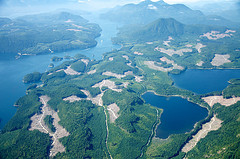
Photo credit: Sam Beebe on Flickr
All employers are required by law to plan for emergencies, but this is complicated by many factors for employers with crews in remote locations. They need to be ready if a worker is injured or there’s a forest fire, earthquake, landslide, or other disaster.
“Emergency Response Planning means having the right information, training and equipment to respond safely when an injury or other unexpected event occurs,” reads Emergency Response Planning, a web page on the BC Forest Safety Council website. “Is your company ready for all of the emergencies it may face?”
WorkSafeBC is producing a video on remote emergency evacuation, to be released in 2015, the first in a series of resources for the forest industry.
What does it take to be ready?
To plan effectively, here are a few of the questions employers need to consider:
“Can your workers describe their physical location (GPS, latitudes/longitudes) for all sites?” reads Emergency Response Planning: A confidential survey for employers.
“Helicopters will need VHF radio frequencies so you can communicate air to ground. Other agencies might also need to reach you. Do you have actual radio frequencies on your radios available to everyone at all times?”
“How often (on average) do you perform emergency drills, on how many workers and on how many sites? Have you ever had a drill to test whether you can carry a person in a stretcher across the block?”
The silviculture industry has been looking at this issue and wrote a draft report. In it, the BC SAFE Silviculture Program describes the challenges, proposed solutions, and plans for outreach and education for the many stakeholders involved in emergency response planning.
Stakeholders include include individual forest companies, rural communities in the BC north and Vancouver Island, medical authorities, the Union of BC Municipalities, the Canadian Radio-television and Telecommunications Commission, WorkSafeBC, and the BC Forest Safety Council.
“This is a relatively new topic for many employers. Sure, they already have emergency response plans or have been provided them, but now we’re asking people to dig in further,” says Lisa Houle, a forestry specialist with WorkSafeBC’s Industry and Labour Services.
“This involves taking a good look and considering if the plan is robust enough to ensure that help can be made available at all times, for all sites and conditions, in as efficient a way as possible. It’s not easy to get help in the bush. A good plan needs to be something more than what’s written on a piece of paper. It needs to be relevant, practised, and communicated.”
Please get in touch via Comments if you have experiences to share about this topic.



With regards to radio communication.
Is there a provincial emergence radio Chanel frequency .
I have worked around helicopters for about five years now and they seem to always have to come onto our channel for communication . Of course this is where an ERP comes into effect stating what frequency we are using.
But if there is a designated frequency for emergency situations then everyone could program to this.
At present I am not aware of such a frequency .Not to say there is not one in place and I am just not aware if it.
Bruce Boyes
Thanks for your question. I will find an answer for you.
Bruce: My contact at WorkSafeBC says you make a good point. At present, there is no such dedicated radio frequency – but that is the kind of question and issue now coming to the surface as industry assesses the situation.